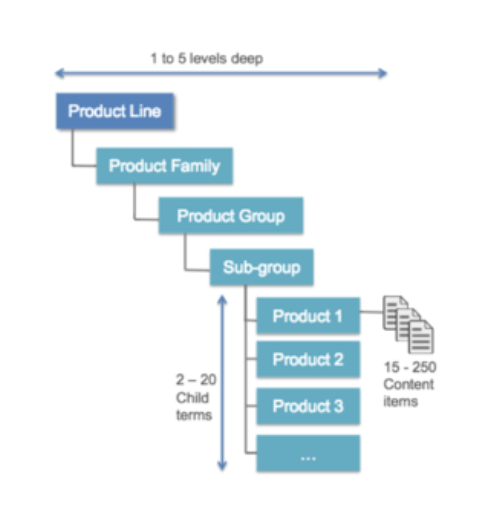What Is a Taxonomy?
A taxonomy is a scheme of classification, a vocabulary of terms grouped into categories and subcategories. It involves organizing digital content using clear, logical categories and associated tags so that users searching a website can more easily find what they’re looking for.
Taxonomy is not meta data. Nor is it navigation. It’s also not just a big group of tags.
A taxonomy:
- Employs a controlled vocabulary, organized by hierarchy and containing both parent and child tags.
- Aligns with a site’s content, including navigation and attributes, but typically does not duplicate all content. Therefore, the way you choose to organize your taxonomy will likely differ from how content gets organized in the navigation.
- Is often built and maintained in the website’s content management system, but can also be managed via dedicated software.
A Taxonomy Hierarchy Example
The following diagram shows an example of a hierarchy, in which there are five levels of tagging within a product line. Some taxonomies will not require going as deep as five levels.

Benefits for B2B Marketing
When done well—taking into account how your B2B audience interacts with your digital channels, a good taxonomy helps ensure your content is:
- Clear and accurate: A standardized vocabulary gives you consistent labels for all your content and assets across all formats (e.g., html, pdf, video, audio).
- Flexible: Using a tagging system allows for easier content reuse—for example, bundles of topical theme-driven content can be gathered instantly and related content can be accurately associated.
- Findable: When it is used to standardize copy and tag content, your site is more likely to return accurate search results and get users what they want.
- Easy to manage: When your editorial and production staff have a clear sense of the content and how to apply a taxonomy, they’re more likely to maximize its potential.
In addition to enabling relevant filtering within a search engine and returning accurate results based on assigned tags, a taxonomy can assist with content display and on-page filtering, personalization and recommendations, and reuse of content for syndication and enabling RSS feeds.
Need Help Optimizing Your Website Taxonomy?
Tendo can help you organize your digital content into clear, logical categories and tags that enhance personalization and help your users find what they need. Some of the world’s top B2B brands have reaped the benefits of our taxonomy and tagging services. To learn more about how we can help, contact us today.


